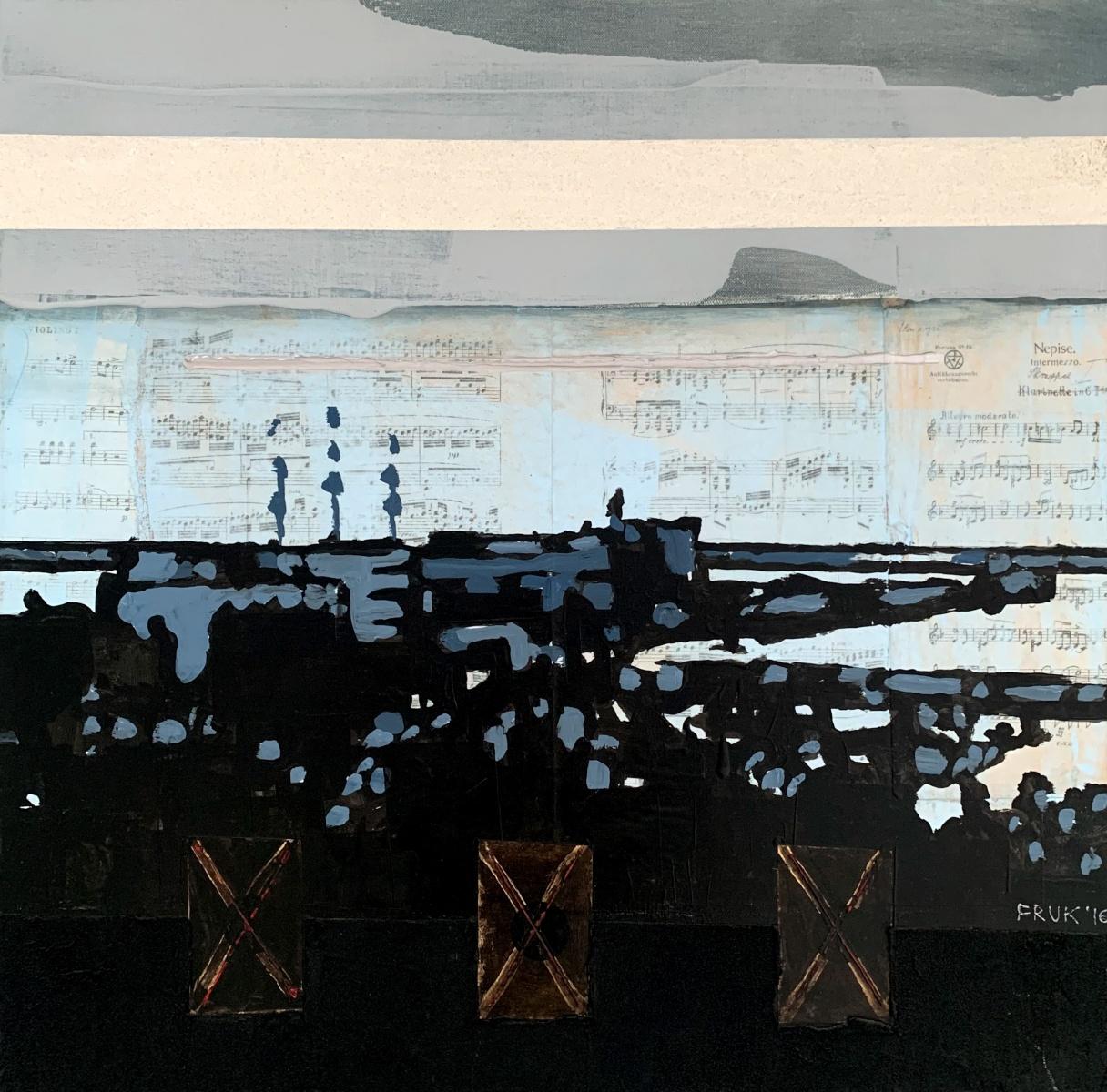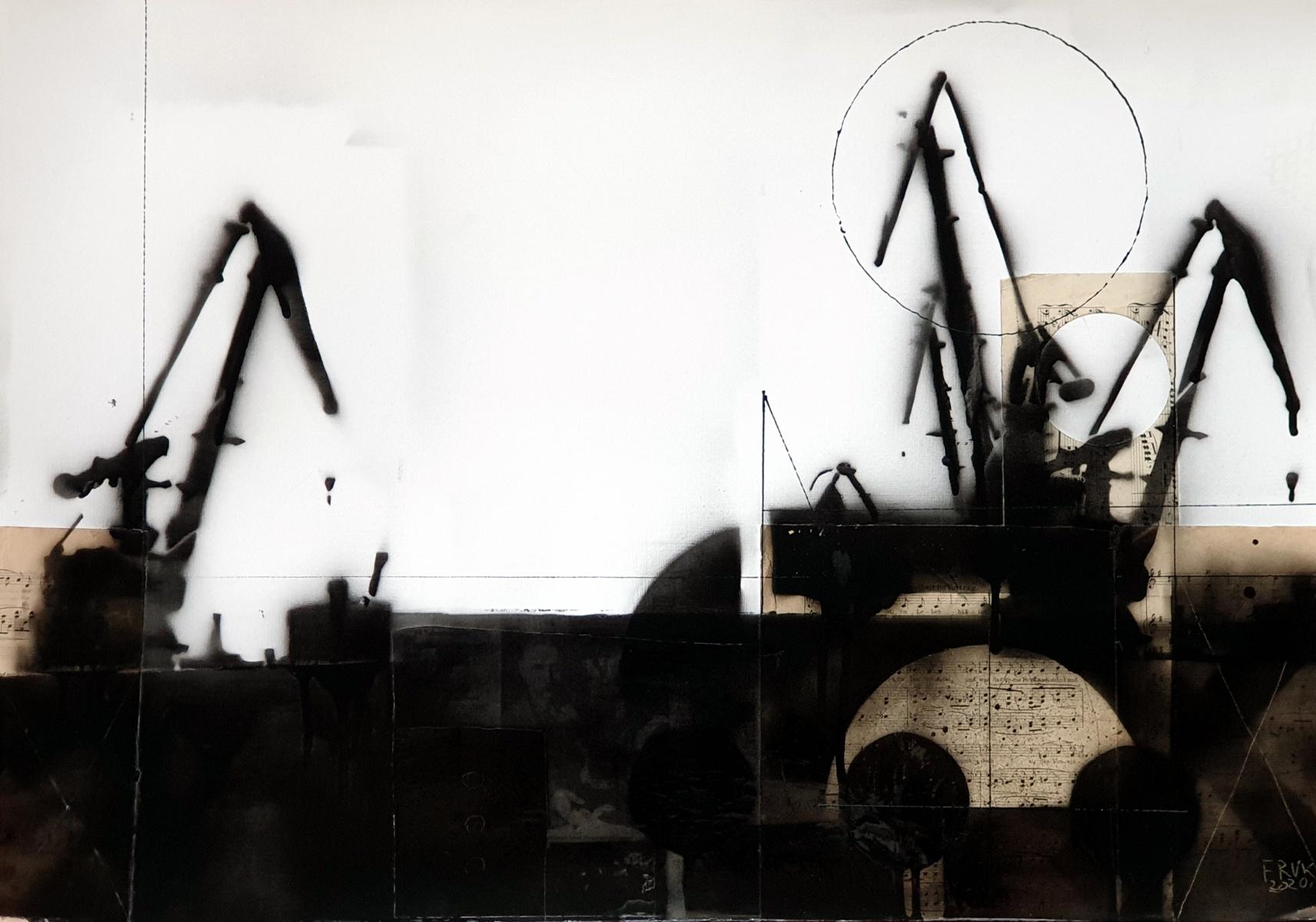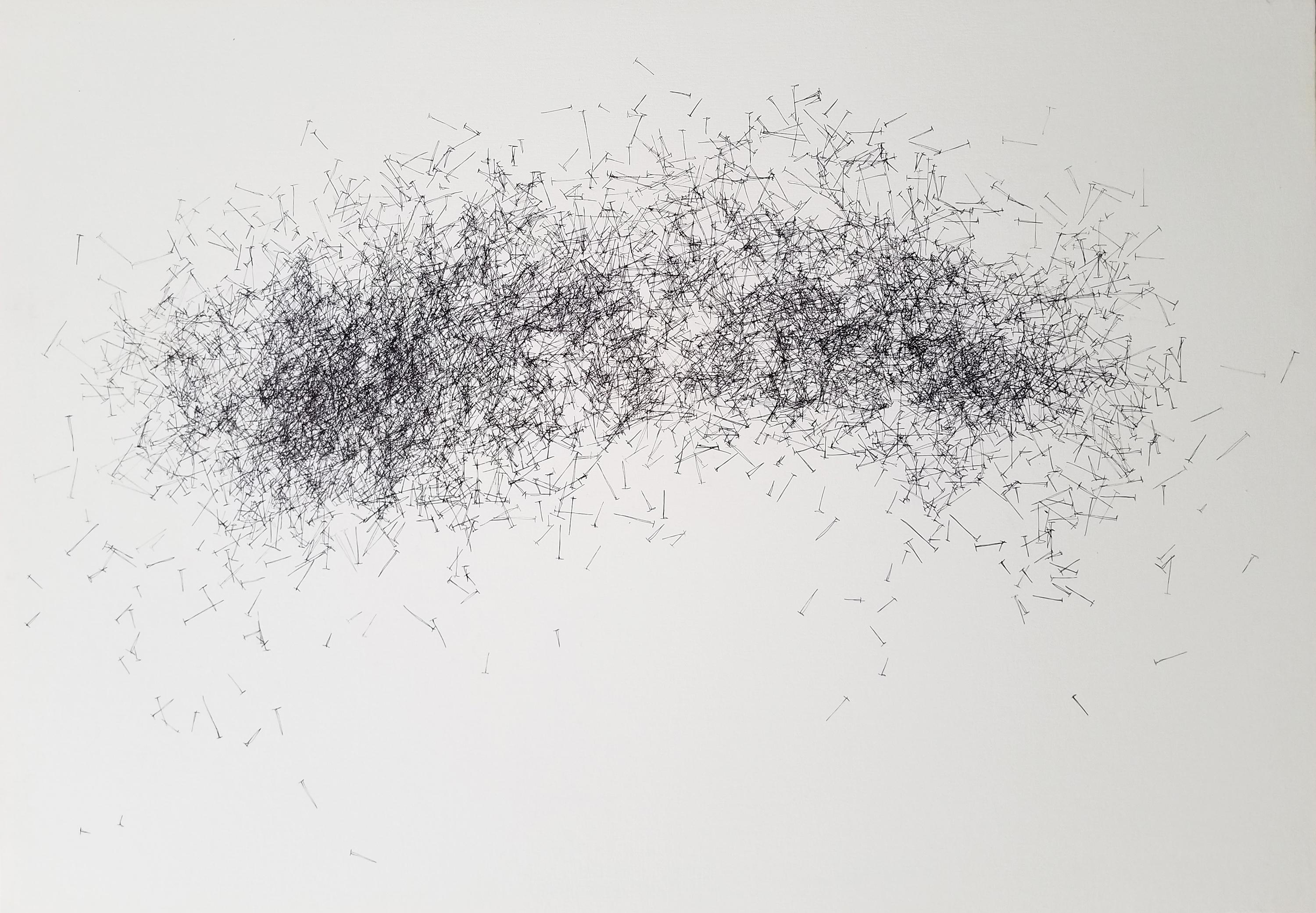Items Similar to The Way Out, figural abstract vibrant orange geometric acrylic painting
Want more images or videos?
Request additional images or videos from the seller
1 of 10
Clarence Holbrook CarterThe Way Out, figural abstract vibrant orange geometric acrylic painting1992
1992
About the Item
Clarence Holbrook Carter (American, 1904-2000)
The Way Out, 1992
Acrylic on paper
Signed and dated upper right
24 x 30 inches
Figural abstract vibrant orange geometric painting.
Clarence Holbrook Carter achieved a level of national artistic success that was nearly unprecedented among Cleveland School artists of his day, with representation by major New York dealers, scores of awards and solo exhibits, and streams of praise flowing from pens of the top art critics. Over the course of his 60+ year career Carter evolved from an exceptionally fine American Scene painter capable of evoking deep reservoirs of mood, into an abstractionist with a strongly surrealist bent.
- Creator:Clarence Holbrook Carter (1904-2000, American)
- Creation Year:1992
- Dimensions:Height: 24 in (60.96 cm)Width: 30 in (76.2 cm)
- Medium:
- Movement & Style:
- Period:
- Condition:
- Gallery Location:Beachwood, OH
- Reference Number:1stDibs: LU176829679272
About the Seller
No Reviews Yet
Vetted Seller
These experienced sellers undergo a comprehensive evaluation by our team of in-house experts.
Established in 1975
1stDibs seller since 2022
Typical response time: <1 hour
- ShippingRetrieving quote...Ships From: Beachwood, OH
- Return PolicyA return for this item may be initiated within 14 days of delivery.
More From This SellerView All
- Interior, large, colorful figural abstract red, orange, blue acrylic of coupleBy Richard AndresLocated in Beachwood, OHRichard Andres (American, 1927-2013) Interior, 1976 acrylic on canvas signed lower right, signed and titled verso 50 x 59.5 inches Richard Andres was born in Buffalo, New York in 1927. A graduate of the Cleveland Institute of Art in 1950, he was immediately drafted and served for two years in the army as a mural painter. He received his Master of Arts from Kent State in 1961. A frequent exhibitor at galleries and museums and winner of multiple May Show prizes, Andres taught art in the Cleveland Public Schools for 28 years, as well as teaching the University of Buffalo, the Cleveland Institute of Art and the Western Reserve University. Very little in Richard Andres’ childhood would have predicted his love of classical music, mid-century-modern architecture and certainly not his lifelong passion for art and in particular abstract art. Richard’s father, Raymond, had no more than a third-grade education, and his mother, Clara, was one of thirteen children – only three of whom lived into adulthood and none of whom attended high school. They lived, when Richard was a boy, in a dingy area of Buffalo, NY in a walk-up apartment situated above a tavern. Raymond and Clara supplemented the income from their factory jobs in the bar downstairs with Raymond playing ragtime on the piano and Clara serving drinks. This often left Richard and his two older brothers at home alone to fend for themselves. The two older boys, Raymond and Russell, were - unlike Richard- rather rough and tumble and entertained themselves with stickball, boxing and the like. Richard, on the other hand, from a very young age liked to draw, or better yet even, to paint with the small set of watercolors he received for Christmas one year. Paper, however, at the height of the depression, was hard to come by. Luckily, Clara used paper doilies as decoration for the apartment and Richard would contentedly paint and then cut up doilies, gluing the pieces together to create collages. At eight-years-old, he discovered the Albright-Knox Museum (then known as the Albright Art Gallery) and spent several hours a week there studying the paintings. He was particularly fond of Charles Burchfield‘s landscapes, enamored with their ‘messiness’ and thinking that they somehow captured more ‘feeling’ than works he was previously familiar with. For his tenth Christmas, he asked for and received a ‘how-to’ paint book by Elliot O’Hare. Through this self-teaching, he assembled the portfolio needed for acceptance to Buffalo Technical High School where he studied Advertising Arts. In his Junior year, he was encouraged to enter a watercolor painting, “Two Barns,” in the national 1944-45 Ingersoll Art Award Contest and was one of twelve grand prize winners – each one winning one hundred dollars. More importantly the painting was exhibited at the Carnegie Institute Galleries, which resulted in his winning a national scholarship to the Cleveland School of Art (The Cleveland Art Institute). He flourished at the art school under the tutelage of faculty members such as Carl Gaertner, as well as that of visiting artists such as William Sommer and Henry George Keller. He would say in later years that Gaertner, in particular, influenced his attitude toward life as well as art. “Gaertner,” Andres said, “believed that there was no need to be a ‘tortured artist’, that an artist should rather enjoy beauty, family, and life in general.” Free to spend his days as he chose, he wandered the Cleveland Art Museum for most of the hours he was not attending classes or painting; the remaining time was spent drinking coffee at a local hangout with art school friends – which is where he met fellow Henry Keller scholarship winner, Avis Johnson. Richard was immediately smitten with Avis, but being rather shy, it took him the entire summer of 1948 to build up his courage to ask her out. Over that summer he ‘thought about Avis’ and worked in a diner to save money. He also used the hundred-dollar prize money won in High School to visit the first Max Beckmann retrospective in the United States at the City Art Museum in St. Louis. Over a half century later he spoke of that exhibit with a reverence usually reserved for spiritual matters, “I walked in and it was like nothing I had ever seen before... the color...It just glowed.” Returning to campus in the Fall, the first thing he did was go to the coffee shop in hopes of finding Avis. He did, and she, upon seeing him, realized that she was also smitten with him. They quickly became known as ‘the couple’ on campus, and a year later, with Richard being drafted for the Korean war, they were quickly married by a Justice of the Peace, celebrating after with family at Avis’s Cleveland home. As a gift, faculty member John Paul Miller...Category
1970s Abstract Expressionist Abstract Paintings
MaterialsAcrylic
- Mandala No. 5, Blue Abstract Ovoid Mid-Century PaintingBy Clarence Holbrook CarterLocated in Beachwood, OHClarence Holbrook Carter (American, 1904-2000) Mandala No. 5, 1968 Acrylic on scintilla Signed on verso 29.5 x 22 inches Clarence Holbrook Carter achieved a level of national artist...Category
1960s Abstract Abstract Paintings
MaterialsAcrylic
- Rainbow Mandala, Mid Century Abstract Red and Yellow Acrylic PaintingBy Clarence Holbrook CarterLocated in Beachwood, OHClarence Holbrook Carter (American, 1904-2000) Rainbow Mandala, 1983 Acrylic on scintilla Signed and dated lower right 30 x 22 inches Clarence Holbrook Carter achieved a level of na...Category
1980s Abstract Abstract Paintings
MaterialsAcrylic
- Green and Red Mandala, Abstract Oval Painting by Ohio Artist Clarence CarterBy Clarence Holbrook CarterLocated in Beachwood, OHClarence Holbrook Carter (American, 1904-2000) Green and Red Mandala, 1969 Acrylic on scintilla Signed and dated lower right 24.75 x 18 inches Clarence Holbrook Carter achieved a l...Category
1960s Abstract Abstract Paintings
MaterialsAcrylic
- Expanding Mandala, Black and Orange Abstract Oval Mid-Century PaintingBy Clarence Holbrook CarterLocated in Beachwood, OHClarence Holbrook Carter (American, 1904-2000) Expanding Mandala, c. 1970s Acrylic on scintilla 23 x 30 inches Clarence Holbrook Carter achieved a level of national artistic success...Category
1970s Abstract Abstract Paintings
MaterialsAcrylic
- Panama Garden, Mid-century abstract expressionist modern workBy Richard AndresLocated in Beachwood, OHRichard Andres (American, 1927-2013) Panama Garden, c. 1964 acrylic on canvas signed lower right, signed and titled verso 46 x 38 inches Richard Andres was born in Buffalo, New York in 1927. A graduate of the Cleveland Institute of Art in 1950, he was immediately drafted and served for two years in the army as a mural painter. He received his Master of Arts from Kent State in 1961. A frequent exhibitor at galleries and museums and winner of multiple May Show prizes, Andres taught art in the Cleveland Public Schools for 28 years, as well as teaching the University of Buffalo, the Cleveland Institute of Art and the Western Reserve University. Very little in Richard Andres’ childhood would have predicted his love of classical music, mid-century-modern architecture and certainly not his lifelong passion for art and in particular abstract art. Richard’s father, Raymond, had no more than a third-grade education, and his mother, Clara, was one of thirteen children – only three of whom lived into adulthood and none of whom attended high school. They lived, when Richard was a boy, in a dingy area of Buffalo, NY in a walk-up apartment situated above a tavern. Raymond and Clara supplemented the income from their factory jobs in the bar downstairs with Raymond playing ragtime on the piano and Clara serving drinks. This often left Richard and his two older brothers at home alone to fend for themselves. The two older boys, Raymond and Russell, were - unlike Richard- rather rough and tumble and entertained themselves with stickball, boxing and the like. Richard, on the other hand, from a very young age liked to draw, or better yet even, to paint with the small set of watercolors he received for Christmas one year. Paper, however, at the height of the depression, was hard to come by. Luckily, Clara used paper doilies as decoration for the apartment and Richard would contentedly paint and then cut up doilies, gluing the pieces together to create collages. At eight-years-old, he discovered the Albright-Knox Museum (then known as the Albright Art Gallery) and spent several hours a week there studying the paintings. He was particularly fond of Charles Burchfield‘s landscapes, enamored with their ‘messiness’ and thinking that they somehow captured more ‘feeling’ than works he was previously familiar with. For his tenth Christmas, he asked for and received a ‘how-to’ paint book by Elliot O’Hare. Through this self-teaching, he assembled the portfolio needed for acceptance to Buffalo Technical High School where he studied Advertising Arts. In his Junior year, he was encouraged to enter a watercolor painting, “Two Barns,” in the national 1944-45 Ingersoll Art Award Contest and was one of twelve grand prize winners – each one winning one hundred dollars. More importantly the painting was exhibited at the Carnegie Institute Galleries, which resulted in his winning a national scholarship to the Cleveland School of Art (The Cleveland Art Institute). He flourished at the art school under the tutelage of faculty members such as Carl Gaertner, as well as that of visiting artists such as William Sommer and Henry George Keller. He would say in later years that Gaertner, in particular, influenced his attitude toward life as well as art. “Gaertner,” Andres said, “believed that there was no need to be a ‘tortured artist’, that an artist should rather enjoy beauty, family, and life in general.” Free to spend his days as he chose, he wandered the Cleveland Art Museum for most of the hours he was not attending classes or painting; the remaining time was spent drinking coffee at a local hangout with art school friends – which is where he met fellow Henry Keller scholarship winner, Avis Johnson. Richard was immediately smitten with Avis, but being rather shy, it took him the entire summer of 1948 to build up his courage to ask her out. Over that summer he ‘thought about Avis’ and worked in a diner to save money. He also used the hundred-dollar prize money won in High School to visit the first Max Beckmann retrospective in the United States at the City Art Museum in St. Louis. Over a half century later he spoke of that exhibit with a reverence usually reserved for spiritual matters, “I walked in and it was like nothing I had ever seen before... the color...It just glowed.” Returning to campus in the Fall, the first thing he did was go to the coffee shop in hopes of finding Avis. He did, and she, upon seeing him, realized that she was also smitten with him. They quickly became known as ‘the couple’ on campus, and a year later, with Richard being drafted for the Korean war, they were quickly married by a Justice of the Peace, celebrating after with family at Avis’s Cleveland home. As a gift, faculty member John Paul Miller...Category
1960s Abstract Expressionist Abstract Paintings
MaterialsAcrylic
You May Also Like
- Gdynia 2 - Contemporary Figurative & Abstract Oil Painting Black & WhiteBy Lukasz FruczekLocated in Warsaw, PLoil, acrylic and collage on canvas Gdynia is Polish city at the Baltic Sea A Polish artist, Lukasz Fruczek was born in 1975. He studied at the Fine Arts School in Gdansk, with a s...Category
2010s Abstract Abstract Paintings
MaterialsCanvas, Paper, Oil, Acrylic
- Cranes 5 - Black & white painting, Mixed media, Collage, Polish artBy Lukasz FruczekLocated in Warsaw, PLŁUKASZ FRUCZEK (born in 1975) Between 1995 and 2000 studied painting in the Department of Painting and Graphic Art of the Academy of Fine Arts in Gdansk. In 2001 graduated with hono...Category
2010s Abstract Abstract Paintings
MaterialsPaper, Mixed Media, Acrylic
- Cranes 3 - Black & white painting, Mixed media, Collage, Polish artBy Lukasz FruczekLocated in Warsaw, PLŁUKASZ FRUCZEK (born in 1975) Between 1995 and 2000 studied painting in the Department of Painting and Graphic Art of the Academy of Fine Arts in Gdansk. In 2001 graduated with hono...Category
2010s Abstract Abstract Paintings
MaterialsPaper, Mixed Media, Acrylic
- 5, 307 nailsBy John AdelmanLocated in New Orleans, LAJohn Adelman was born in a small town in northwest Ohio in 1969. In 1992, he earned a BFA in painting, drawing and printmaking from Ohio State University in Columbus, Ohio. Upon grad...Category
21st Century and Contemporary Abstract Abstract Paintings
MaterialsAcrylic
- Modernist Abstract Silhouette of a Figure in WhiteBy Jean WallinLocated in Soquel, CACompelling figurative abstract of the silhouette of a figure in white, in a minimalist monochromatic background by Jean Wallin (American). Signed “Wallin” in bottom right corner. Pre...Category
1990s Abstract Expressionist Figurative Paintings
MaterialsAcrylic, Paper
- "Survivor", Abstract Expressionist Figurative in OrangeBy Toni MorleyLocated in Soquel, CAAbstract expressionist composition with a highly abstracted figural form swirling in a monochromatic orange plane by Toni Morley (American, 20th Century). Titled "Survivor" and signe...Category
21st Century and Contemporary Abstract Expressionist Abstract Paintings
MaterialsPaper, Acrylic





